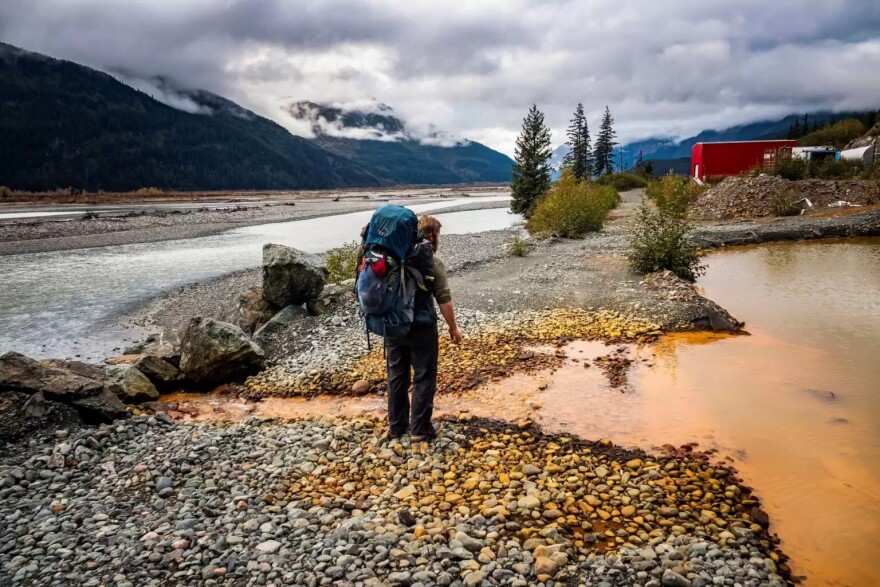Canagold representatives faced resistance from residents about their proposed New Polaris underground gold mine at an open house in Juneau last month.
The mine site is a remote area where the Tulsequah River joins the Taku River in British Columbia, around 40 miles northeast of Juneau. As the mine goes through its environmental assessment across the border, some Alaskans feel they don’t have a meaningful say in the process.
The Taku River runs through the traditional homelands of the T’aaḵu Kwáan. Butch Laiti is president of the Douglas Indian Association, which represents the T’aaḵu Kwáan. He said the tribe isn’t willing to gamble with the health of the river.
“We’re not gonna back down or give way, because there’s too much at stake here,” Laiti said. “If we lose the Taku, and then that’s it, it won’t come back. And that’s the bottom line, right there.”
The mine is projected to produce around 800,000 ounces of gold over about a decade. The project is part of a controversial wave of mining expansion in British Columbia upstream of the Taku, Stikine, and Unuk Rivers in Southeast Alaska.
Laiti said past mining projects in Canada set a precedent of damaging and neglecting the rivers that flow into Southeast.
“I know you understand our nervousness, but a lot of that’s from the history of all the mining that comes out of BC,” Laiti said.
The Tulsequah Chief mine, located just across the river from the New Polaris site, was abandoned in 1957 and has been leaching unsafe levels of toxins, including aluminum, cadmium, chromium, copper, lead, mercury and zinc into the Taku River since.
Canagold CEO Catalin Kilofliski said that the province is cleaning up the site, but it could take a decade. And he said it’s given mining a bad rap.
“I think the issues you mentioned, unfortunately, that’s the legacy of mining,” Kilofliski said. This is the legacy we are faced with — miners too.”
That legacy has continued.
For instance, the Premier gold and silver mine in British Columbia was found responsible for releasing toxic materials into the Portland Canal Watershed for years near Hyder, Alaska, and was fined in March. Also this spring, the Red Chris copper mine in British Columbia was found to have leached heavy metals into the Stikine RiverWatershed. In September, the province fined that mine for failing to monitor the water. Last year, a failure at the Eagle gold mine in Yukon spilled cyanide into the Yukon River Basin.
The state of Alaska signed a non-binding memorandum of understanding with British Columbia a decade ago meant to keep Alaskans informed about water quality beneath existing mines and to engage them in the public process for developing new mines. But some Alaskans say it’s not enough to make sure they’re heard or to protect the waters they depend on.
So far, almost all of the public comments submitted on New Polaris were written with concern for the lower reaches of the Taku River in Alaska.
Heather Hardcastle has been fishing at the mouth of the Taku River since she was a kid, and said the mine could harm this essential salmon run. She’s a campaign advisor at SalmonState, a nonprofit that advocates for salmon habitat across borders, and said the provincial government isn’t required to take Alaskans’ concerns into consideration.
“We still don’t have any kind of binding forum through which those of us downstream have any meaningful say in whether or not and how a mining project is developed,” Hardcastle said.
The U.S. has a treaty with Canada called the Boundary Waters Treaty of 1909. It states that “waters flowing across the boundary shall not be polluted on either side to the injury of health or property on the other.”
Despite pressure from Southeast cities and Alaska’s congressional delegation, the federal government has yet to raise the issue with the International Joint Commission, which is a framework for resolving issues under the treaty.
Canadian officials are mandated to consult with Indigenous peoples on projects that could affect their territories. There’s an ongoing dispute about whether that mandate extends consultation to tribes across the border.
Canagold signed an agreement with the Taku River Tlingit First Nation, whose territory is on the Canada-side of the border, that it won’t build the mine without their consent. It’s unclear when the First Nation will decide. The Taku River Tlingit First Nation did not respond to requests for comment.
New Polaris is now going through Canada’s environmental assessment process. A representative from Canagold said mine construction could start in 2027 at the earliest.

